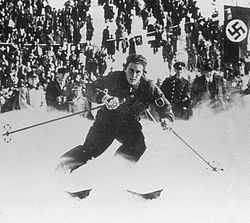1936 Winter Olympics medal table
The 1936 Winter Olympics, officially known as the IV Olympic Winter Games, were an international multi-sport event held in Garmisch-Partenkirchen, Germany, from 6 to 16 February 1936. A total of 646 athletes representing 28 National Olympic Committees (NOCs) participated, 11 NOCs more than the last Winter Games in Lake Placid, United States. NOCs as first-time entrants at the Winter Games included Australia, Bulgaria, Greece, Liechtenstein, Spain, and Turkey. The games featured 17 events in 4 sports across 8 disciplines. These games were the last time that the same country hosted the Summer Olympics and Winter Olympics in the same year, with the 1936 Summer Olympics being held from 1 to 16 August 1936 in Berlin.
Overall, athletes representing 11 NOCs won at least one medal, and 8 NOCs won at least one gold medal. Norway won the most gold medals and the most overall medals, with 7 and 15 respectively. Germany's team obtained their first Winter Olympic gold medal, with alpine skier Christl Cranz winning the women's combined event. Norway and Sweden both achieved podium sweeps at the games, with the former in the individual nordic combined event with Oddbjørn Hagen winning the gold, Olaf Hoffsbakken winning the silver, and Sverre Brodahl winning the bronze, and the latter in the men's 50 kilometre cross-country skiing event with Elis Wiklund winning the gold, Axel Wikström winning the silver, and Nils-Joel Englund winning the bronze.
Speed skater Ivar Ballangrud of Norway won the most gold medals and overall medals for an individual at the games, with three and four respectively. Ballangrud became the first athlete since middle- and long-distance runner Paavo Nurmi of Finland at the 1924 Summer Olympics in Paris, France, to attain the greatest Olympic performance by an individual.
Medal table

The medal table is based on information provided by the International Olympic Committee (IOC) and is consistent with IOC conventional sorting in its published medal tables. The table uses the Olympic medal table sorting method. By default, the table is ordered by the number of gold medals the athletes from a nation have won, where a nation is an entity represented by a NOC. The number of silver medals is taken into consideration next and then the number of bronze medals. If teams are still tied, equal ranking is given and they are listed alphabetically by their IOC country code.
* Host nation (Germany)
Notes
References
Citations
Bibliography
External links
- "Garmisch-Partenkirchen 1936". Olympics.com. International Olympic Committee.
- "1936 Winter Olympics". Olympedia.com. Retrieved 24 February 2021.